How To Master The Art Of Frozen Pictures: A Comprehensive Guide
Do you want to learn how to create stunning frozen pictures? Capturing moments in time and freezing motion has never been more accessible with modern technology. Whether you're a beginner or an experienced photographer, understanding the techniques behind frozen pictures can elevate your skills to the next level.
Frozen pictures have become increasingly popular in photography circles. They allow artists to capture fleeting moments, preserving them for eternity. From wildlife photography to sports and even everyday life, frozen pictures bring life to still images, making them a favorite among photographers worldwide.
In this article, we will explore everything you need to know about frozen pictures. From understanding the basics to advanced techniques, you'll discover how to create breathtaking images that capture motion perfectly. Let’s dive in!
Read also:Bones Zack Addy Unveiling The Genius Behind The Lab
Table of Contents
- What Are Frozen Pictures?
- History of Frozen Photography
- Equipment Needed for Frozen Pictures
- Techniques for Freezing Motion
- Tips for Beginners
- Advanced Techniques for Frozen Pictures
- Common Mistakes to Avoid
- Software and Editing for Frozen Pictures
- Famous Photographers Known for Frozen Pictures
- Conclusion
What Are Frozen Pictures?
Frozen pictures refer to photographs that capture motion in such a way that it appears to be paused in time. This technique is achieved by using fast shutter speeds to freeze the subject's movement. The result is a sharp, detailed image that highlights the motion without blurring.
Photographers often use frozen pictures to capture dynamic scenes, such as athletes in action, birds in flight, or even water droplets mid-air. These images are not only visually striking but also provide a deeper appreciation for the beauty of motion.
History of Frozen Photography
The concept of frozen pictures dates back to the early days of photography. In the late 19th century, photographers like Eadweard Muybridge began experimenting with capturing motion through sequential photography. This laid the foundation for modern frozen photography.
As technology advanced, cameras became capable of faster shutter speeds, allowing photographers to capture motion more effectively. Today, with digital cameras and smartphones, creating frozen pictures is easier than ever before.
Equipment Needed for Frozen Pictures
Cameras and Lenses
To capture frozen pictures, you'll need a camera that supports fast shutter speeds. DSLRs, mirrorless cameras, and even high-end smartphones can produce excellent results. Additionally, consider using lenses with fast apertures to ensure proper exposure in low-light conditions.
Accessories
Some essential accessories include:
Read also:Scott Sasso The Visionary Behind 10deep And The Evolution Of Streetwear
- External flash or speedlights for additional lighting
- Tripods to stabilize the camera during long exposures
- Memory cards with high write speeds to handle large files
Techniques for Freezing Motion
Mastering frozen pictures requires understanding key techniques:
- Shutter Speed: Use a fast shutter speed (e.g., 1/1000th of a second) to freeze motion effectively.
- Aperture: Adjust the aperture to control depth of field and ensure proper exposure.
- ISO: Increase ISO settings in low-light conditions, but be mindful of noise.
Tips for Beginners
For those new to frozen photography, here are some tips to get started:
- Practice shooting in manual mode to gain better control over settings.
- Start with simple subjects, like water splashes or pets running, to build confidence.
- Experiment with different angles and perspectives to add interest to your images.
Advanced Techniques for Frozen Pictures
High-Speed Sync Flash
Using high-speed sync flash allows you to freeze motion while maintaining proper exposure. This technique is especially useful in bright environments where a fast shutter speed might lead to underexposure.
Burst Mode
Burst mode enables you to capture multiple frames per second, increasing your chances of getting the perfect shot. This is ideal for fast-moving subjects like wildlife or sports.
Common Mistakes to Avoid
Even experienced photographers make mistakes when capturing frozen pictures. Here are some common pitfalls to watch out for:
- Using too slow a shutter speed, resulting in motion blur.
- Overexposing images by setting ISO too high.
- Not focusing properly on the subject, leading to blurry shots.
Software and Editing for Frozen Pictures
Post-processing plays a crucial role in enhancing frozen pictures. Software like Adobe Lightroom and Photoshop offers tools to refine details, adjust exposure, and sharpen images. Editing can bring out the best in your frozen pictures, making them stand out.
Famous Photographers Known for Frozen Pictures
Several renowned photographers have made frozen pictures their signature style:
- Eadweard Muybridge: Pioneered motion photography in the 19th century.
- Steve McCurry: Known for capturing vivid, frozen moments in his portraits.
- Henri Cartier-Bresson: Mastered the "decisive moment" in street photography.
Conclusion
Capturing frozen pictures is both an art and a science. By understanding the techniques, equipment, and tips discussed in this article, you can elevate your photography skills and create stunning images. Remember to practice regularly and experiment with different subjects and settings.
We encourage you to share your experiences and tips in the comments below. Additionally, explore other articles on our site to deepen your knowledge of photography. Together, let's continue to push the boundaries of frozen pictures and inspire creativity!


